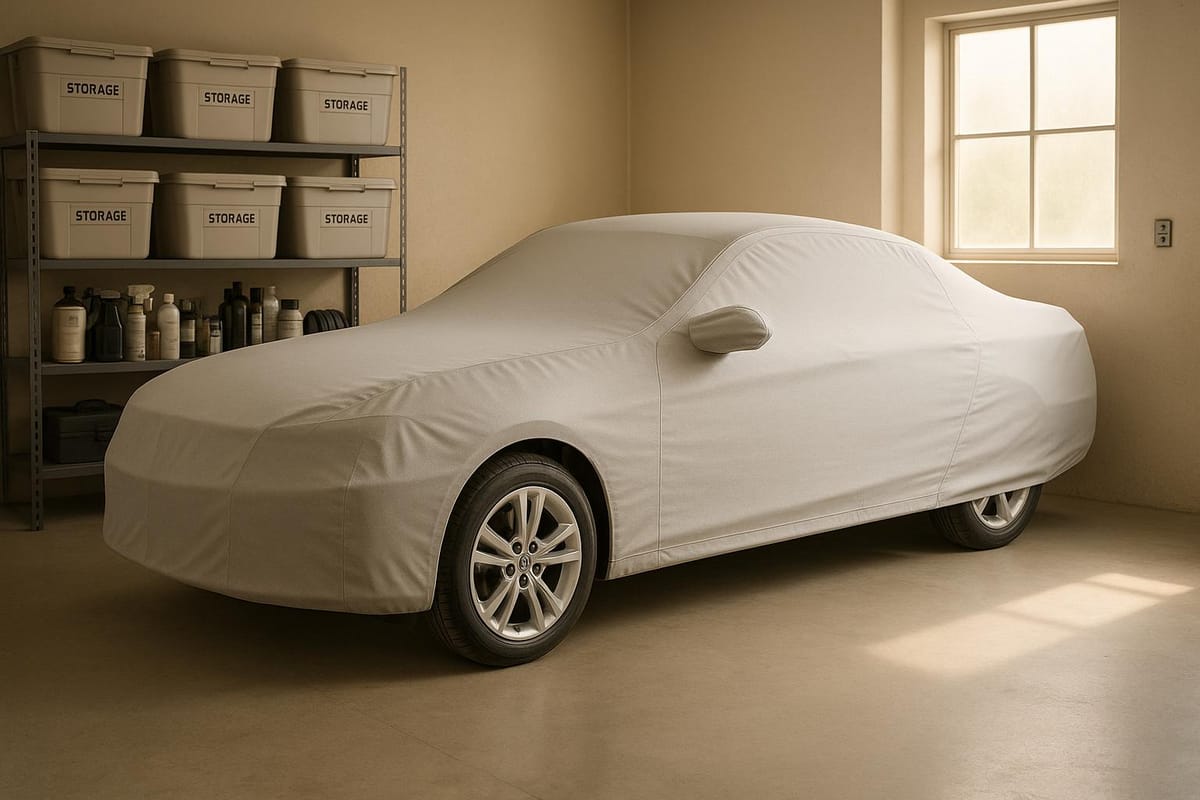Ultimate Guide to Seasonal Car Storage
Learn essential tips for seasonal car storage to protect your vehicle's value and condition, from preparation to post-storage checks.

Want to keep your car in top condition during seasonal storage? Here's how:
- Preparation is key: Clean your car thoroughly, maintain fluids, protect surfaces, and use moisture absorbers to prevent rust, cracks, and UV damage.
- Choose the right storage: Indoor climate-controlled facilities (£120–£400/month) offer the best protection for luxury and classic cars. Outdoor options are cheaper but less secure.
- Legal and insurance requirements: File a SORN to avoid road tax and ensure you have laid-up insurance to protect against theft or damage.
- Post-storage checks: Inspect fluids, tyres, brakes, and the battery before driving. Address issues like flat spots or rust immediately.
Quick Tip: Proper storage can help your car retain up to 15% more value over five years. For high-value cars, professional storage with climate control and advanced security is recommended.
Ready to keep your car safe and road-ready? Let’s dive into the details.
Ultimate Car Storage Guide: The Secrets of Long-Term Storage. Don’t Let Your Car Rot
Pre-Storage Car Preparation
Preparing your car for storage, whether it’s a cherished classic or a modern high-value vehicle, is a must to safeguard its condition and value. Proper preparation - cleaning, maintaining fluids, and protecting surfaces - helps to ensure your car remains in great shape while stored.
Clean and Protect Surfaces
Start with a comprehensive exterior wash, paying special attention to the undercarriage, where road salt and grime often collect. After washing, apply a high-quality liquid wax. This creates a protective shield against moisture and other contaminants.
For the interior, vacuum thoroughly and wipe down surfaces with a microfibre towel, focusing on areas prone to moisture. Leather and vinyl surfaces should be conditioned to avoid cracking over time.
"Any dirt, salt, and grime that remains on your car's exterior can cause deterioration, so it's important that you wash your classic car thoroughly before it goes into storage."
Place moisture absorbers or silica gel packs inside the cabin to manage humidity. Use sunshades and seat covers to prevent UV damage, and finish by covering your car with a breathable, vehicle-specific cover.
Maintain Fluids and Battery
Keeping your car’s fluids in check is vital to prevent internal damage during storage. Here's a quick guide:
| Fluid Type | Action | Purpose |
|---|---|---|
| Engine Oil | Change before storage | Removes contaminants that could harm the engine |
| Coolant | Fill with antifreeze | Prevents freezing and corrosion in the cooling system |
| Brake Fluid | Top up to maximum | Reduces moisture build-up and prevents rust |
| Fuel | Fill tank and add stabiliser | Prevents moisture formation and fuel degradation for up to 12 months |
For the battery, clean the terminals using a neutralising solution and apply a corrosion-resistant spray or petroleum jelly. To maintain the battery’s charge, either disconnect the negative terminal or use a maintainer to keep it above 12.4 volts.
Protect Tyres and Prevent Pests
Tyres need special attention for long-term storage. Wash them with mild detergent and water, ensuring they are completely dry. To avoid flat spots, consider using tyre cushions or jack stands if the car will be stationary for an extended period.
Pests can also pose a threat to your car during storage. Take these precautions:
- Seal off entry points, including the tailpipe.
- Use rodent-deterrent tape to protect wiring harnesses.
- Place natural deterrents like peppermint oil around the storage area.
"If you see damage from rodents, take action immediately to both deter the animals and keep your car running. Chewed wires are a serious concern and will require professional assessment and potentially repair."
Keep tyres inflated to the recommended pressure and store the car in a climate-controlled area, away from direct sunlight and extreme temperatures. As a general rule, tyres should be replaced after 10 years, regardless of their condition, as advised by Continental.
Storage Location Selection
Picking the right storage location is essential to keep your vehicle in top condition. Here's a closer look at storage types and what they offer.
Indoor vs Outdoor Storage
The choice between indoor and outdoor storage often comes down to your budget, the type of vehicle, and the local climate. Indoor storage provides better protection and more security, but it comes at a higher cost. On the other hand, outdoor storage is more affordable and convenient, making it a good option for short-term needs.
| Storage Type | Monthly Cost | Key Benefits | Best Suited For |
|---|---|---|---|
| Indoor Climate-Controlled | £120–£400 | Full weather protection, stable conditions | Luxury cars, classics, supercars |
| Indoor Basic | £100–£250 | Weather protection, basic security | Daily drivers, modern vehicles |
| Covered Outdoor | £60–£160 | Partial weather protection, easy access | Short-term storage, durable vehicles |
| Open Outdoor | £40–£120 | Affordable, convenient | Temporary storage, weather-resistant vehicles |
Security Requirements
Security is a critical factor when choosing a storage facility. Look for locations that offer:
- 24/7 CCTV surveillance with night vision
- Access control systems using unique credentials
- Perimeter security, such as electric fencing
- Alarm systems linked to immediate response teams
- Well-lit premises, ideally with motion-activated lighting
Facilities with multiple layers of security are ideal. This is especially important considering over 1 million vehicles were stolen in 2023.
Temperature and Humidity Control
For proper vehicle preservation, maintaining the right temperature and humidity is key. Aim for:
- Temperature range: 13°C to 29°C (55°F to 85°F)
- Relative humidity: 40% to 60%
These conditions can reduce corrosion risk by 90% and extend the lifespan of your vehicle’s interior by 50%. Facilities equipped with climate monitoring systems and industrial dehumidifiers are especially important for classic cars or vehicles with sensitive materials.
UK Laws and Insurance
If you're planning to store your vehicle, it's not just about physical preparations. Ensuring you meet legal and insurance requirements is equally important to protect your vehicle's value.
SORN and MOT Rules
When storing your vehicle off public roads, you’ll need to file a Statutory Off Road Notification (SORN) with the DVLA. This declaration exempts your vehicle from road tax and standard insurance requirements while it's in storage.
| SORN Violations and Penalties | Details |
|---|---|
| Failing to declare SORN | £80 fixed penalty (up to £1,000 if unpaid) |
| Driving a SORNed vehicle (except to an MOT) | Up to £2,500 fine |
| Parking a SORNed vehicle on a public road | Court prosecution and fines |
A SORNed vehicle must be kept on private property, such as a garage, driveway, or other private land where you have permission to store it.
"When you SORN your vehicle, it can't be kept on a public road – it must be kept on private land, this can include a garage or a driveway." – RAC
As for MOT requirements, a vehicle under SORN does not need a valid MOT while in storage. However, before taking it back on the road, it must pass an MOT. The only exception is driving the vehicle to a pre-booked MOT test.
While adhering to SORN and MOT rules is essential, securing proper insurance coverage for your vehicle during storage is just as important.
Insurance During Storage
Although insurance isn’t legally required for a SORNed vehicle, it’s a wise move to protect your investment. There are tailored insurance options for vehicles in storage:
- Laid-up Cover: This type of insurance covers risks like theft, fire, accidental damage, and vandalism.
- For high-value or classic cars, you can opt for comprehensive storage coverage. For example, Lancaster Insurance Services offers laid-up cover specifically designed for classic and valuable vehicles.
If you own a rare or investment-grade vehicle, maintaining comprehensive insurance during storage is particularly crucial. It provides peace of mind against unexpected events that could diminish the vehicle's value.
When you're ready to return your car to the road, remember to reinstate standard motor insurance. Keep in mind that taxing the vehicle automatically cancels the SORN under Section 143 of the Road Traffic Act 1988.
Storage for High-Value Cars
When it comes to safeguarding high-value cars, such as supercars, classic vehicles, or investment-grade automobiles, standard storage options simply don't cut it. These prized assets require customised care that goes beyond basic protection, ensuring both their preservation and security.
Supercar and Classic Car Care
High-value cars need precise climate control to maintain their condition. Professional storage facilities typically keep temperatures between 13–24°C and humidity levels at 45–55%. While pre-storage preparation is essential for any vehicle, high-value cars demand extra attention to detail and protection.
Key maintenance practices include:
- Using a trickle charger to keep the battery charged
- Adjusting tyre pressure to avoid flat spots
- Periodically starting the engine to circulate fluids
- Scheduling professional detailing services
Studies show that vehicles stored in professional facilities retain their value far better than those kept at home. Alongside these maintenance measures, advanced security systems play a crucial role in safeguarding these investments.
High-Level Security
Professional storage facilities implement robust, multi-layered security systems to protect high-value cars. These measures are designed to deter theft and vandalism effectively.
| Security Measure | Purpose | Benefit |
|---|---|---|
| 24/7 CCTV | Continuous monitoring | Real-time threat detection |
| Biometric access | Restricted entry | Prevents unauthorised access |
| Motion sensors | Perimeter protection | Immediate alert system |
| Dedicated on-site personnel | Physical presence | Rapid response capability |
Facilities equipped with these systems report 95% fewer incidents of theft and vandalism compared to home storage.
In addition to security, investment-grade storage often includes:
- Insurance coverage up to £1 million per vehicle
- Professional appraisal services
- Transportation logistics
- Routine maintenance inspections
"When you entrust your vehicle to professional storage, you're not just protecting it from immediate threats like theft and weather damage; you're ensuring its long-term value preservation through comprehensive care that includes climate control, regular maintenance checks, and expert handling".
The cost of secured storage typically ranges from £150 to £400 per month, depending on the location and level of service. This price reflects the extensive care and protection provided.
Post-Storage Car Revival
Now that your car has been safely stored and maintained, it’s time to bring it back to life. By following these steps, you can ensure your car is fully prepared and ready to hit the road. These checks build on the work you did before and during storage, giving you peace of mind that everything is in top condition.
Initial Checks
Start by giving the engine bay a thorough inspection. Look over fluid levels, check for any leaks, and make sure to remove any covers from the intake or exhaust. Also, carefully examine the wiring and hoses for signs of rodent damage - this is a common issue during storage.
Here’s a quick breakdown:
- Engine Bay: Double-check all fluid levels and look out for any leaks or signs of degradation. Don’t forget to remove any protective covers, and take a moment to inspect the garage floor for evidence of fluid leaks.
- Battery: Test the battery. If the voltage is below 12.4V, recharge it. Clean off any corrosion from the terminals and ensure the connections are tight and secure.
- Other Components: Use the table below to guide your inspection of key parts:
| Component | What to Check | Warning Signs |
|---|---|---|
| Tyres | Inflation and condition | Flat spots from storage |
| Brake Rotors | Surface condition | Rust or pitting |
| Wipers | Rubber quality | Brittleness or cracks |
| Engine Belts | Tension and wear | Fraying or looseness |
Road Safety Inspection
Once you’ve completed the initial checks, it’s time to confirm the car is roadworthy with a few final tests.
- Engine Start: Start the engine and let it idle for a while. Pay close attention to any unusual noises, smoke, or leaks. If the car has been stored for more than six months, it’s a good idea to add a few drops of oil to each cylinder before starting to avoid a dry start.
- Brake Check: Test the brake pedal. Light rust on the rotors should disappear after some gentle use, but if you hear grinding noises, feel an odd pedal response, or notice persistent squealing, schedule a professional inspection.
- Test Drive: Take the car on a short, local drive to assess its overall performance. During the drive, focus on:
- Steering responsiveness
- Brake performance
- Engine behaviour
- Transmission operation
- Any unusual noises or vibrations
If you notice any major issues during these tests, document them and arrange for a professional inspection right away. A little extra caution now can save you from bigger problems down the line.
Conclusion
Seasonal storage is key to maintaining both the condition and value of your vehicle. By focusing on thorough preparation, secure storage practices, and meeting legal requirements, you can ensure your car remains in top shape and ready for the road when needed.
Opting for professional storage is a smart choice. Facilities accredited by the Self Storage Association (SSA UK) provide advanced climate control and top-notch security. In fact, using professional storage can help your car retain up to 15-20% more resale value compared to storing it at home.
"When you choose professional storage, you're not just parking your car; you're ensuring its long-term value and pristine condition with expert care and state-of-the-art security measures." – Specialized Automotive
For UK car owners, filing a SORN and obtaining storage insurance are essential steps to guard against theft, fire, and accidental damage. Research has shown that vehicles kept in climate-controlled environments retain up to 15% more of their value over five years compared to those stored in standard conditions.
When it's time to bring your car back into use, following detailed revival procedures will help restore it to peak performance.
FAQs
What happens if I don’t declare a SORN when storing my car off-road in the UK?
If you don’t declare a SORN (Statutory Off Road Notification) when keeping your car off the road in the UK, you could face some hefty penalties. These include fines of up to £2,500 or five times the amount of any unpaid vehicle tax, depending on which is greater. On top of that, your vehicle could be clamped or even impounded, with additional costs required to get it back.
By law, you must declare a SORN if your vehicle is untaxed, uninsured, and not being driven on public roads. Thankfully, the process is simple and helps you avoid unnecessary fines while your car is off the road.
Why is climate-controlled storage important for preserving high-value cars?
When it comes to protecting high-value cars, climate-controlled storage is a game-changer. By keeping temperature and humidity levels steady, it shields vehicles from the harsh effects of environmental extremes. Without this protection, cars can suffer from rust, corrosion, and the breakdown of materials like leather and rubber. For instance, too much moisture can lead to mould, while extreme heat can cause paint to fade and interior materials to crack or deteriorate.
This controlled environment doesn’t just protect the car’s appearance - it also safeguards its mechanical and electrical systems. Stable conditions reduce the risk of condensation, which can wreak havoc on sensitive components. By maintaining these optimal conditions, climate-controlled storage ensures that high-value cars remain in excellent shape, preserving both their performance and their worth over time.
How can I prepare my car to get back on the road after seasonal storage?
To get your car back on the road after it’s been in storage, here are some essential steps to follow:
- Change the oil: If the oil hasn’t been replaced recently, it’s a good idea to do so. Old oil can break down over time and may harm your engine.
- Examine the tyres: Check the tyre pressure and tread depth. Inflate the tyres to the recommended levels, and if the tread is too worn, consider replacing them.
- Reconnect and check the battery: Ensure the battery is charged. If it’s not holding a charge anymore, it’s time for a replacement.
- Clean the car: Give your vehicle a thorough clean, both inside and out, to remove dirt and debris that might cause damage.
- Take a short drive: Once everything seems in order, go for a quick drive. This helps circulate fluids and ensures all systems are working properly.
These steps will help get your car back in shape, making it safe and ready to hit the road again.




